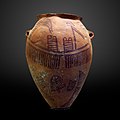Portal:Ancient Egypt
|
THE ANCIENT EGYPT PORTAL
Showcased content about Ancient Egypt Ancient Egypt was a civilization of ancient Northeast Africa. It was concentrated along the lower reaches of the Nile River, situated within the contemporary territory of modern-day Egypt. Ancient Egyptian civilization followed prehistoric Egypt and coalesced around 3100 BC (according to conventional Egyptian chronology) with the political unification of Upper and Lower Egypt under pharaoh or king Menes (often identified with Narmer). The history of ancient Egypt unfolded as a series of stable kingdoms interspersed by periods of relative instability known as "Intermediate Periods". The various kingdoms fall into one of three categories: the Old Kingdom of the Early Bronze Age, the Middle Kingdom of the Middle Bronze Age, or the New Kingdom of the Late Bronze Age. Ancient Egypt reached the pinnacle of its power during the New Kingdom, ruling much of Nubia and a sizable portion of the Levant. After this period, it entered an era of slow decline. During the course of its history, ancient Egypt was invaded or conquered by a number of foreign powers, including the Hyksos, the Nubians, the Assyrians, the Achaemenid Persians, and the Macedonians under Alexander the Great. The Greek Ptolemaic Kingdom, formed in the aftermath of Alexander's death, ruled until 30 BC, when, under Cleopatra, it fell to the Roman Empire and became a Roman province. Egypt remained under Roman control until 642 AD, when it was conquered by the Rashidun Caliphate. The success of ancient Egyptian civilization came partly from its ability to adapt to the conditions of the Nile River valley for agriculture. The predictable flooding and controlled irrigation of the fertile valley produced surplus crops, which supported a more dense population, and social development and culture. With resources to spare, the administration sponsored mineral exploitation of the valley and surrounding desert regions, the early development of an independent writing system, the organization of collective construction and agricultural projects, trade with surrounding regions, and a military intended to assert Egyptian dominance. Motivating and organizing these activities was a bureaucracy of elite scribes, religious leaders, and administrators under the control of a pharaoh, who ensured the cooperation and unity of the Egyptian people in the context of an elaborate system of religious beliefs.[1] The many achievements of the ancient Egyptians include the quarrying, surveying, and construction techniques that supported the building of monumental pyramids, temples, and obelisks; a system of mathematics, a practical and effective system of medicine, irrigation systems, and agricultural production techniques, the first known planked boats, Egyptian faience and glass technology, new forms of literature, and the earliest known peace treaty, made with the Hittites. Ancient Egypt has left a lasting legacy. Its art and architecture were widely copied, and its antiquities were carried off to be studied, admired or coveted in the far corners of the world. Its monumental ruins have inspired the imaginations of travelers and writers for millennia. A newfound respect for antiquities and excavations in the early modern period by Europeans and Egyptians has led to the scientific investigation of Egyptian civilization and a greater appreciation of its cultural legacy. (Full article...) Selected article - Gaza, also called Gaza City, is a city in the Gaza Strip, Palestine. As of 2022, it was the largest city in the State of Palestine, with 590,481 inhabitants in 2017. The city is spread across an area of 45 square kilometres (17 sq mi). Gaza is one of the principal coastal cities in the country, home to Palestine's only port. Located some 76.6 kilometres (47.6 mi) southwest of the country's proclaimed capital East Jerusalem, the city is located on the coast of the Mediterranean Sea. Prior to the 2023 Israel–Hamas war, it was the most populous city in the State of Palestine, when massive displacement happened during the war. Inhabited since at least the 15th century BC, Gaza has been dominated by different peoples and empires throughout its history. The Philistines made it a part of their pentapolis after the ancient Egyptians had ruled it for nearly 350 years. Under the Roman Empire, Gaza experienced relative peace and its Mediterranean port flourished. In 635 AD, it became the first city in the Palestine region to be conquered by the Rashidun army and quickly developed into a centre of Islamic law. However, by the time the Crusader states were established in 1099, Gaza was in ruins. In later centuries, Gaza experienced several hardships—from Mongol raids to severe flooding and locust swarms, reducing it to a village by the 16th century, when it was incorporated into the Ottoman Empire. During the first half of Ottoman rule, the Ridwan dynasty controlled Gaza and the city went through an age of great commerce and peace. The municipality of Gaza was established in 1893. (Full article...) Selected picture
The Rosetta Stone is a fragment of a granite stele containing a decree written in Hieroglyphs, Demotic, and Greek. Discovered in 1799, the stone contributed greatly to the process of hieroglyph decipherment. Did you know...
News5th September 2018. Rock-cut Tomb discovered in a 4,000-year-old Elite Cemetery August 2018: in the tomb of the mayor of Memphis Ptahmose who dates around 1300 BC was found well preserved cheese, more than 3000 years old. [1] Selected biography -Darius I (Old Persian: 𐎭𐎠𐎼𐎹𐎺𐎢𐏁 Dārayavaʰuš; c. 550 – 486 BCE), commonly known as Darius the Great, was the third King of Kings of the Achaemenid Empire, reigning from 522 BCE until his death in 486 BCE. He ruled the empire at its territorial peak, when it included much of West Asia, parts of the Balkans (Thrace–Macedonia and Paeonia) and the Caucasus, most of the Black Sea's coastal regions, Central Asia, the Indus Valley in the far east, and portions of North Africa and Northeast Africa including Egypt (Mudrâya), eastern Libya, and coastal Sudan. Darius ascended the throne by overthrowing the Achaemenid monarch Bardiya (or Smerdis), who he claimed was in fact an imposter named Gaumata. The new king met with rebellions throughout the empire but quelled each of them; a major event in Darius's life was his expedition to subjugate Greece and punish Athens and Eretria for their participation in the Ionian Revolt. Although his campaign ultimately resulted in failure at the Battle of Marathon, he succeeded in the re-subjugation of Thrace and expanded the Achaemenid Empire through his conquests of Macedonia, the Cyclades, and the island of Naxos. (Full article...) General imagesThe following are images from various ancient Egypt-related articles on Wikipedia.
Related portalsWikiProjectsMain topics
Notable Pharaohs
CategoriesRecognized content
Featured articles
Featured listsGood articles
Did you know? articles
Featured pictures
In the News articlesMain page featured articles
Main page featured listsPicture of the day pictures
Things to do
WikimediaThe following Wikimedia Foundation sister projects provide more on this subject:
Sources
Discover Wikipedia using portals |








































































